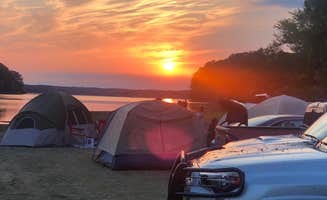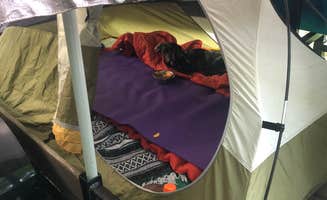Tent camping options around Cadiz, Kentucky concentrate within Land Between the Lakes (LBL) National Recreation Area where the winter lake levels typically drop 5-6 feet from summer levels, creating wider shorelines at many campsites. The region averages 49 inches of rainfall annually with summer temperatures frequently exceeding 90°F. Many primitive sites require backwoods camping permits costing $7 per night, available from visitor centers or online.
What to do
Swimming at Sugar Bay Campground: The warm lake waters make excellent swimming spots with no lifeguard supervision. A camper noted, "Swimming allowed in Sugar Bay and in late September the water was warm." Sugar Bay Campground features shoreline access directly from most campsites.
Kayaking from Ginger Bay: Launch directly from shoreline campsites with multiple water access points. "We fished, we hiked, we kayaked!! We all enjoyed the peaceful exclusivity this site offers," reports one visitor about Ginger Bay Basic Camping Area.
Wildlife watching near Redd Hollow: Early mornings offer prime wildlife viewing opportunities along the shoreline. "Bring your atv, dirt bike or sidexside and cruise the trails right along Lake Barkley. They have over 100 miles of trails," notes a Redd Hollow camper.
Collect persimmons in fall: Old Boy Scout Campground features numerous persimmon trees producing edible fruit in autumn. A visitor mentioned, "There were a lot of persimmon trees loaded with fruit, if you'd like to make jam."
What campers like
Secluded shoreline spots: Forest Service Road 343 offers multiple primitive sites directly on the water. "This is one of the best spots I've found on this app. I had one other person show up to cook, but they left shortly after. Beautiful view with a nice fire pit, I was able to swim and had a great night to myself!" writes one camper about Forest Service Rd 343.
Star visibility at higher sites: The elevated campsites at Sugar Bay provide excellent night sky viewing. "Nice and quiet, beautiful stars at night and good cell service if you needed it," reports a camper who stayed at site 9.
Private water-view sites: Cravens Bay offers numerous secluded locations. "We stayed here in the middle of July in 2019! Wow was it hot! It also had a bit of flooding, how ever it made it easier for our girls to launch their kayaks and swim. Great spot for kayaking and tent camping. We were the only ones there so it was perfect!" recalls a visitor to Cravens Bay.
Low traffic weekday camping: Many primitive campgrounds remain nearly empty Monday through Thursday, particularly in spring and fall. A camper noted about Ginger Bay, "Incredible back country campsite, for use with dispersed camping permit. Right on the water, no other people for 2 days!"
What you should know
Road conditions vary significantly: Forest Service roads require careful driving and sometimes high-clearance vehicles. "The road coming in is a little washed out but not too pitted. I'd recommend AWD/4WD and 8+ inches of clearance, especially if it has rained because it's pretty steep in sections," warns a camper about Forest Service Rd 343.
Seasonal campers provide assistance: Long-term campers at established sites often help newcomers. At Cravens Bay, one visitor mentioned, "There were some seasonal campers there who were very helpful and friendly (even cut up some timber for us to burn)."
Boat ramp congestion: Some primitive camping areas share space with day-use boaters. A visitor to Ginger Bay observed, "When we visited the ramp was somewhat busy with day-use visitors."
Animal awareness needed: While no large predators inhabit the area, smaller wildlife requires attention. "Realize when you dispersed camp at LBL though there are no large predators there are coyotes so if you have dogs keep an eye out. Every time I disperse camp I hear coyotes throughout the night, sometimes very close by," notes a ranger at LBL FS154 - Dispersed.
Tips for camping with families
Lake level considerations: Winter pool conditions expose more shoreline for easier water access. A reviewer mentioned, "I was there during the lake's winter pool, so the water was very low, leaving a lot of easy walkable entry areas into the bay or inlet area."
Road trip planning: Reach major services before entering remote areas. "It is a drive to get anywhere, so bring everything you need. The roads leading back are all paved," advises a camper about Cravens Bay.
Simpler campground alternatives: For families wanting basic amenities, Linton Recreation Area provides more facilities. "This campground was really nice, clean, and loved that it was easy to find and in a great location. The campsites had a table and a small fire ring that we used for making delicious s'mores," shares a visitor to Linton.
Cell service considerations: Some higher elevation sites maintain cellular connections while most shoreline locations have limited or no service. A Sugar Bay camper noted, "good cell service if you needed it" at their hillside site.
Tips from RVers
Small trailer access: Most primitive sites accommodate smaller trailers but require careful navigation. "Were there with a 26 foot towable. Definitely would like to go back and camp there again," mentions a visitor about Redd Hollow Campground.
Turn-around challenges: Limited space at some campgrounds makes maneuvering difficult. One Cravens Bay camper reported, "We stayed at site 20 with a 36' travel trailer we had to actually drive all the way to the end of the campground to turn around so we could back into the site."
Campground layout awareness: Understanding the terrain helps with site selection. A visitor described Cravens Bay: "Cravens Bay basically breaks down into two areas, the low ground (first sites upon entering) and the high ground (sites further in at the top of the hill), there are some sites scattered in-between these two areas."
Road narrowing issues: Expect tight passages on many access routes. "The road leading into the campsite is paved but narrow, the roads at the campsite are well hard packed gravel and very narrow," warns an RV camper.






